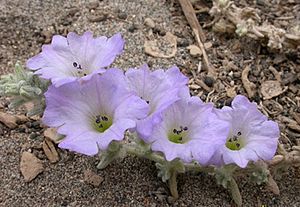Nolana facts for kids
Quick facts for kids Nolana |
|
|---|---|
 |
|
| Nolana confinis | |
| Scientific classification |
|
| Kingdom: | Plantae |
| Clade: | Tracheophytes |
| Clade: | Angiosperms |
| Clade: | Eudicots |
| Clade: | Asterids |
| Order: | Solanales |
| Family: | Solanaceae |
| Subfamily: | Solanoideae |
| Tribe: | Nolaneae |
| Genus: | Nolana L.f. |
| Species | |
|
See text |
|
Nolana, also known as the Peruvian bell flower, is a group of plants. These plants can be either annuals (meaning they live for one year) or perennial plants (meaning they live for more than two years). They belong to the nightshade family, which also includes tomatoes and potatoes! Most Nolana plants grow naturally in Chile and Peru. Some types, like N. paradoxa, are often studied by scientists. They help us learn about how flower colors work.
Contents
What is the Nolana Plant Family?
Nolana is a special group of plants within the nightshade family. It's the only group in this family that has a unique type of fruit. This fruit breaks apart into smaller, seed-like pieces called mericarps. Even with this different fruit, Nolana's flowers and other parts look similar to other nightshade plants. Scientists believe Nolana is most closely related to plants like Lycium (which includes wolfberries) and Grabowskia.
How Many Nolana Species Are There?
There are many different kinds of Nolana plants. Scientists have identified about 85 to 89 different species. Each species has its own unique features and places where it grows best.
Common Types of Nolana Plants
Here are some of the well-known species of Nolana:
- Nolana acuminata
- Nolana atriplicifolia
- Nolana crassulifolia
- Nolana galapagensis
- Nolana humifusa
- Nolana prostrata
- Nolana rupicola
- Nolana sedifolia
- Nolana tenella
- Nolana paradoxa
See also
 In Spanish: Nolana para niños
In Spanish: Nolana para niños

